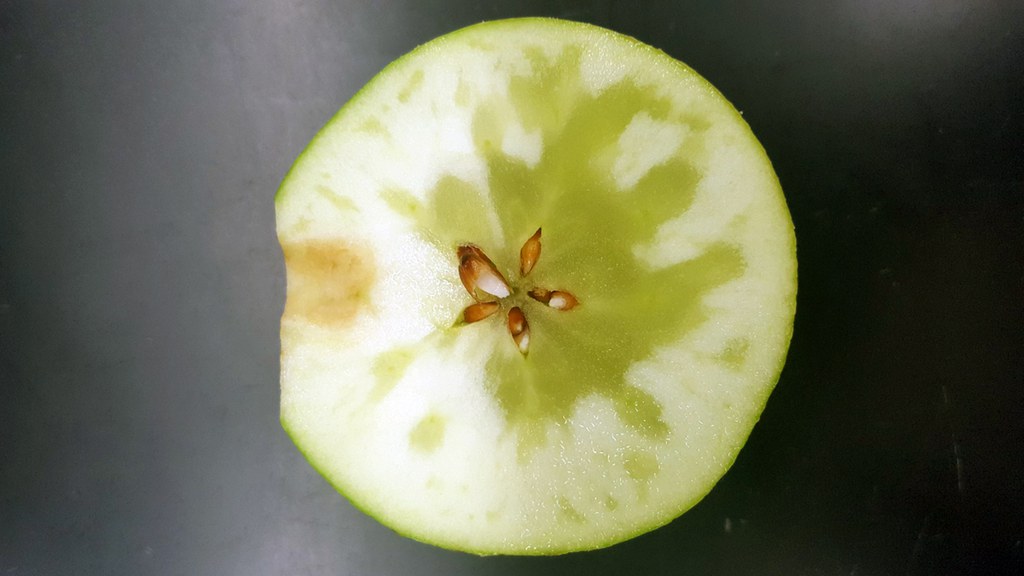Granny Smith fruit harvested from Western Maryland are nearing storage maturity, and Cripps Pink fruit are beginning to lose ground color.
Apple harvest in 2017 has been well ahead of "normal." This week we evaluated Cripps Pink (Pink Lady) and Granny Smith samples from the University of Maryland's farm in Keedysville. This orchard is located at a warm, low-elevation site in Washington County, Maryland. These trees sampled are budded onto size-controlling rootstocks and trained to the tall-spindle system.
Cripps Pink
Like many of the apple samples we have tested this year, fruit size in Cripps Pink was relatively small. Cripps Pink fruit are beginning to lose ground color, and have a bit of red color. While these fruit measured almost 14°Brix, they still did not taste very sweet due to their high acidity. During the next few weeks the sweetness will increase as the sugar-to-acid ratio increases. While the fruit have not developed much red color, a loss of starch in the fruit flesh has begun.
| Cultivar | Diameter (inches) | Red Color (%) | Ground Color | Firmness (pounds) | Soluble Solids (°Brix) | Starch Pattern (1-8 scale) |
|---|---|---|---|---|---|---|
| Cripps Pink | 3 | 31.8 | Light Green | 21.9 | 13.7 | 2 |
| Granny Smith | 3.2 | 0 | Green | 18.3 | 13.2 | 4 |
There was some variability in the starch pattern index of the apples (see photo). While most fruit had just lost starch in their core region, a small percentage of those evaluated had begun to lose starch in the flesh and will be ready to spot-pick soon. With cool October weather, the Cripps Pink harvest window should begin at this site in the next ten days. That will be well ahead of the typical harvest period for Cripps, which has been in early November.
Granny Smith
The Granny Smith apples spot-picked were larger than the Cripps and ready to for long-term storage. Starch staining of these apples showed that these fruit had lost starch in the core and were beginning to lose starch in the flesh (See the photo comparing starch patterns on Cripps Pink and Granny Smith).
During these evaluations, we noted two disorders in Granny Smith fruit--sunburn and water core. Like many sites, this orchard received plenty of rainfall in June and July but below-average rainfall in August and September. While the shaded side of the fruit was still green, the sunny side of many apples were sunburned. This damage ranged from mild peel browning to severe pitting (see photo). The average damage - per fruit - was estimated at 12 percent. Many of these will be unacceptable for the fresh market. In addition to Granny Smith, we also expect sunburn will be problematic in other sunburn-susceptible October varieties like Fuji.

Comparison of Cripps Pink and Granny Smith Apples. Starch staining pattern and color development of Cripps Pink (upper rows) and Granny Smith (lower rows) apples harvested from tall-spindle plantings at Keedysville, Maryland during the first week of October 2017. Photo: Audra Bissett, University of Maryland

Granny Smith Sunburn. Sunburn development on the sunny side of Granny Smith (upper two rows of apples) compared to the shaded side of the fruit (lower two rows). Fruit were harvested from tall-spindle trees on Maryland's Piedmont region during the first week of October 2017. Photo: Audra Bissett, University of Maryland

Severe Watercore in Granny Smith Apples. Watercore development in the flesh of Granny Smith apples. Fruit were harvested from tall-spindle trees on Maryland's piedmont region during the first week of October 2017. Photo - Audra Bissett, University of Maryland


